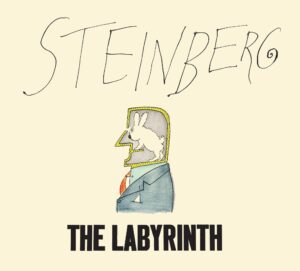 Among my parents’ art books was a big book of drawings I loved as a child and now have and love still: Saul Steinberg’s The Labyrinth. It has just been republished by the New York Review of Books. Saul Steinberg (1914-1999) was from a Romanian Jewish family. He studied architecture in Milan and in 1958 fled Fascism to land eventually in the USA. Steinberg spoke of himself as a ‘modernist without portfolio’. He worked in many media – did gallery exhibitions, ads, stage design and numerous covers for The New Yorker magazine, covers he continued to produce until the end of his life. Most of the drawings in The Labyrinth first appeared in that magazine. The new edition of Steinberg’s book has an introduction and an afterword. My original edition has no text except a short one on the flyleaf: The Labyrinth is a continuation of Steinberg’s autobiography. As in his former books, he is discovering and inventing a great variety of events:
Among my parents’ art books was a big book of drawings I loved as a child and now have and love still: Saul Steinberg’s The Labyrinth. It has just been republished by the New York Review of Books. Saul Steinberg (1914-1999) was from a Romanian Jewish family. He studied architecture in Milan and in 1958 fled Fascism to land eventually in the USA. Steinberg spoke of himself as a ‘modernist without portfolio’. He worked in many media – did gallery exhibitions, ads, stage design and numerous covers for The New Yorker magazine, covers he continued to produce until the end of his life. Most of the drawings in The Labyrinth first appeared in that magazine. The new edition of Steinberg’s book has an introduction and an afterword. My original edition has no text except a short one on the flyleaf: The Labyrinth is a continuation of Steinberg’s autobiography. As in his former books, he is discovering and inventing a great variety of events:
Illusion, talks, music, women, cats, dogs, birds, the cube, the crocodile, the museum. Moscow and Samarkand (winter, 1956), other Eastern countries, America, motels, baseball, horse racing, bullfights, art, frozen music, words, geometry, harpies, etc.’
And that is introduction enough. I remember an introduction from an elementary school art class: ‘Take a line for a walk.’ Sometimes this is all Steinberg does. But with genius. The line might even remain just a straight line across a page but begin as a clothesline with laundry, continue as a table top with objects on it, and end as the top of a railway aqueduct with scenery seen through the arches below. An unbroken line of narrow vertical curves becomes a very individual little dog. A family of four – and their dog – are pictured simply through connected rectangles. All Steinberg’s individual figures are done with a minimum of lines; part of a body suggests the whole and a mouth-line and eye-dots the face. A hat, a triangle of arm with fingers holding a wineglass or a cigarette make a distinct, even archetypical, character. There are other figures with comic-strip speech balloons containing not words but intricate doodles, all again delineating a personality. Sometimes the balloon extends into a pedestal or a mound on which the speaker stands.
Steinberg’s landscapes, street scenes and crowd scenes are equally funny, imaginative and evocative. I especially liked his Russia and Samarkand with cupolas, heroic statues, stocky fur-hatted Muscovites. For me, under the amazing inventiveness, ingenuity, and often sardonic wit, there is also something deeper, a nameless nostalgia and wistfulness, a child-like wonder at the whole colour, drama and absurdity of the human condition. But that may be just the response of my own Central European soul. In any case, it’s a marvellous book, and I hope that in its wake Steinberg’s two earlier volumes of autobiographical drawings will be republished too. The one called The Passport might be particularly appropriate for our grim age of migration and refugees.
Frances Oliver
Volume 34 no 4 March/April 2020 p 32
